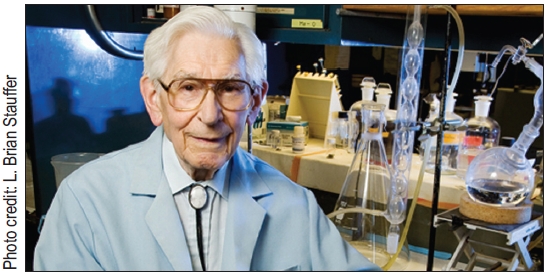Joy and sorrow! First, the joy. This month, October 2014, I take great pride in having the legendary Professor Fred A. Kummerow, Ph.D., as our interviewee. It’s not just that Dr. Kummerow was born 100 years ago on October 4, 1914 and is still hard at work, but also that he has saved many thousands of people from premature death and his research and educational efforts have paved the way to help millions more as time moves forward. It was bad enough that Dr. Kummerow nearly starved to death as a youth, but in the process of separating scientific fact from nutritional fiction, Professor Kummerow has had to endure the wrath of vested interests that gain from having you think otherwise. Readers of this column know to trust the data rather than opinions or “official proclamations.” In business, it may be “Follow the Money,” but in science, it should be “Follow the Data.” And, it must be the whole data—not just data hand-picked to fit a theory in spite of the fact that the total data show the theory to be wrong. Everyone can have their own opinion, but they can’t have their own facts. Let’s look at the facts!
Dr. Kummerow is highly regarded for his efforts to uncover the dangers of trans fats and to remove dangerous man-made fats from our food supply, but his life-saving nutritional efforts began with helping to wipe out the deadly pellagra epidemic in the United States. Today, most people have never heard of pellagra thanks to researchers including Drs. Kummerow, Joseph Goldberger and Conrad Elvehjem, but students of nutrition are familiar with the story of niacin (vitamin B3) being the anti-pellagra vitamin. What a lot of people don’t know is that they had to step on quite a few toes to rid the South of Pellagra (1).

|
|
| Fred A. Kummerow, Ph.D. |
Now, the sorrow: At a time when he should be rejoicing because most of his scientific opponents have finally admitted that he was correct and even the political world is finally catching up to the scientific world in terms of trans fats opposition, I was very saddened to learn that Dr. Kummerow is having to close his laboratory after all these years due to the lack of funding. He is researching Parkinson’s disease and believes he has a very interesting lead to its cure that needs to be tested.
Dr. Kummerow has published about 500 scientific articles, written two books, edited three books and contributed chapters on trans fat and cholesterol in heart disease to six books. He is still publishing scientific articles to this day.
Passwater: You were born in Berlin, Germany, on October 4, 1914. That was a very different time from what most of us know. There was no heart disease epidemic then, but there was a pellagra epidemic in the Southeast United States. Vitamins were just beginning to be discovered and World War I had just started with Austria–Hungary’s war declaration on Serbia. The war lasted until November 1918. What was it like growing up poor in Germany with little food?
Kummerow: When I was small, there was little food for my family. My mother would put my brother and me to bed during the day so we would not use up our energy and require more food. She would read to us and entertain us so that we wouldn’t run around burning calories. Our food staple consisted of a slice of bread with maybe sugar on it and a little coffee for flavor.
My father’s job at the railroad occasionally enabled him to bring home some extra kerosene in a flask. My mother used to exchange these small amounts of kerosene for eggs and vegetables from farmers in the area. In 1923, we were able to move to the United States.
Passwater: I would think that almost starving gave you a special appreciation for food and nutrition.
Kummerow: As I have written in my books, I know firsthand the impact of adding necessary ingredients to food and the difference that it makes in people’s lives. I know that a vitamin lacking in the diet can kill someone, and I know this can be changed.
Passwater: How did you become interested in chemistry?

Kummerow: When I was 12, a relative gave me a chemistry set. I didn’t learn that much from the set, but when I started high school at Boys Technical School, I took three years of chemistry. I enjoyed working in the chemistry lab and after high school I started working for a pharmaceutical company in its lab.
Passwater: You became a biochemist at a time when there were few chemists specializing in biochemistry. How did you get started in this field?
Kummerow: I saved enough money to start my freshman year at the University of Wisconsin in the Milwaukee Extension Division in 1936. In my sophomore year, I transferred to the University of Wisconsin in Madison. I signed up for a National Youth Administration job; money was provided by President Franklin D. Roosevelt and matched by the University. I was told to report to Dr. Steebock in Biochemistry and was assigned to work with his post-doc students for three years. I graduated with a B.S. in chemistry with honors and then in 1939 became a graduate student in biochemistry, with Dr. Steebock as my mentor. My Ph.D. research involved identifying a factor in blood that keeps blood from clotting in arteries. This factor stems from the fatty acid, linoleic acid. Today, we recognize this factor as prostacyclin. Prostacyclin is very important in heart disease to help prevent the blood clots that cause heart attacks.
I received my Ph.D. in 1943 and took a research position at Clemson University to study pellagra. In 1945, I was invited to move to Kansas State University to start a basic research program in lipid (fat) chemistry. Some of my research at Kansas State was on keeping foods from turning rancid. This was an important issue during World War II when American troops were scattered worldwide.
In 1950, I was invited to move my lipid research program to the University of Illinois in Urbana, where I have been ever since.
Passwater: What is pellagra and what is the problem that you solved?
Kummerow: Pellagra is a disease that was  present before 1938 in the southeastern United States. It is a deficiency of niacin. The symptoms of pellagra are swelling of the lips and tongue and swelling of the arms to the point that the skin breaks open. When it reaches this stage, the people usually die. I mentioned that I was at the University of Wisconsin from 1936 to 1943. Niacin had been isolated in food extracts by Casimir Funk, Ph.D., in 1913 (2), but little attention had been paid to it until it was identified as a missing factor in canine black tongue disease in 1938 at the University of Wisconsin by Conrad Elvehjem, Ph.D., and his colleagues (3). It was speculated that this could also be a factor in human pellagra.
present before 1938 in the southeastern United States. It is a deficiency of niacin. The symptoms of pellagra are swelling of the lips and tongue and swelling of the arms to the point that the skin breaks open. When it reaches this stage, the people usually die. I mentioned that I was at the University of Wisconsin from 1936 to 1943. Niacin had been isolated in food extracts by Casimir Funk, Ph.D., in 1913 (2), but little attention had been paid to it until it was identified as a missing factor in canine black tongue disease in 1938 at the University of Wisconsin by Conrad Elvehjem, Ph.D., and his colleagues (3). It was speculated that this could also be a factor in human pellagra.
When I arrived at Clemson, SC, in 1943, thousands of people were still dying of pellagra. I figured out how to put niacin in corn grits, a staple food in the south. By 1945, there were only 12 deaths from pellagra and it is rare today.
Passwater: Let’s see. Some 3,000–6,000 people were dying each year (about five per 100,000 population) when you started researching the disease. It’s now 70 years later and pellagra is rare, so that’s about 250,000 lives saved from premature death (4). Not a bad start.
What was the problem with frozen turkeys and how did you solve it?
Kummerow: The problem with frozen turkeys was that they became rancid after six months of frozen storage. The Army Quartermaster Corp funded me to figure out how to keep the turkeys from becoming rancid. I purchased one-day-old turkeys and divided them into two groups. I fed linseed meal to one group, like they had been doing, and I fed corn meal to the other group. When they reached maturity, I had them slaughtered, dressed and frozen. After six months, I had the home economics department at Kansas State prepare them. They had a test kitchen. After preparing the turkeys, the people fed them could tell by the taste which turkeys were fed the linseed, which made them rancid, and which were fed the corn, which were edible. Today, poultry are fed a diet that ensures they are not rancid after being stored frozen.
Passwater: You were sought after by universities for your lipid programs. Where did you begin?
Kummerow: My first line of research in my lipid program was the chemistry of fat and cholesterol.
Passwater: You’ve seen a lot of change in the common thinking about diet and heart disease. You’ve seen the popular beliefs gradually change from the opposite of your research to finally come around to what you and your research had been saying all along. What were some of your early studies showing us about diet and heart disease?
Kummerow: My early studies showed that trans fat in partially hydrogenated oils was detrimental to the health of humans and rats. In the next phase of the study, I demonstrated that one can have a healthy heart and cardiovascular system by eating foods that contained cholesterol. Unfortunately, these foods were not recommended by physicians that served on the diet committee of the American Heart Association. Most nutritionists and biochemists did not agree with the diet these physicians recommended, however, which led to the cholesterol wars that are still going on today.
 Passwater: The popular advice was to avoid as much saturated fat and cholesterol as possible because they were thought to be the dietary culprits in heart disease. Unfortunately, in spite of overwhelming evidence to the contrary, these erroneous concepts are still being promoted today. I referenced some of your research in my paper “Dietary Cholesterol: Is It Really Related to Heart Disease?” which was published in American Laboratory in 1973 (5). I also discussed the research by Drs. George Mann, David Kritchevsky, Edward Pinckney and many others. There was not a lack of scientific evidence showing that dietary cholesterol was not a factor.
Passwater: The popular advice was to avoid as much saturated fat and cholesterol as possible because they were thought to be the dietary culprits in heart disease. Unfortunately, in spite of overwhelming evidence to the contrary, these erroneous concepts are still being promoted today. I referenced some of your research in my paper “Dietary Cholesterol: Is It Really Related to Heart Disease?” which was published in American Laboratory in 1973 (5). I also discussed the research by Drs. George Mann, David Kritchevsky, Edward Pinckney and many others. There was not a lack of scientific evidence showing that dietary cholesterol was not a factor.
In 1977, I made a challenge on the back cover of my book that said, “If anyone can prove that eating cholesterol caused heart disease, I would donate all of the proceeds from my book to the American Heart Association” (6).
That challenge earned me appearances on major television shows, but no one accepted the challenge nor did anyone even attempt to prove this belief. Instead, the experts shifted to claiming saturated fats were the dietary culprits. Is dietary cholesterol a major factor in heart disease?
Kummerow: No, it is not. You don’t have to feed animals cholesterol to cause atherosclerosis.
Passwater: Well, you certainly have presented the scientific evidence that cholesterol is not an important factor in heart disease in two of your books Cholesterol is Not the Culprit: A Guide to Preventing Heart Disease and Cholesterol Won’t Kill You But Trans Fat Could (7, 8).
We have covered the cholesterol myth in several interviews through the years, recently including “The Cholesterol Paradigm: The Greatest Health Scam of the Century” and “Heart Disease and the Great Cholesterol Myth” (9, 10).
As the renowned lipid (fat chemistry) researcher and past member of the National Academy of Sciences Food and Nutrition Board and USDA Dietary Guidelines Advisory Committees, David Kritchevsky, Ph.D., told us in 1993, “If the experts say ‘A’ and the data say ‘B’—go with the data” (11). The problem is that some scientists have cherry-picked the data to falsely make the scientists’ incorrect theory appear to be true. We have to look at the total data and the total body of science, not just the part that seems to fit someone’s pet theory.
Is high blood cholesterol the major factor in heart disease?
Kummerow: No. Michael DeBakey, M.D., who was a surgeon at Baylor University Medical School—and, by the way invented the bypass technique—stated at the 1975 Federal Trade Commission hearing on eggs that he had performed bypass surgery on patients who needed it, both with low or high cholesterol. Therefore, he didn’t believe cholesterol was the problem.
Passwater: How did this cholesterol nonsense get started?
Kummerow: In 1913, Nikolai Anitschkov, M.D.,  DMedSc., performed studies on rabbits, feeding them cholesterol and eggs, and noted that it caused atherosclerosis in them. Rabbits are vegetarian animals that do not have a biochemical mechanism for handling dietary cholesterol, which comes from animal products, not vegetarian products. It is better to study the effect of cholesterol on arteries in swine, which have arteries and hearts more like humans. They are omnivores like humans (12).
DMedSc., performed studies on rabbits, feeding them cholesterol and eggs, and noted that it caused atherosclerosis in them. Rabbits are vegetarian animals that do not have a biochemical mechanism for handling dietary cholesterol, which comes from animal products, not vegetarian products. It is better to study the effect of cholesterol on arteries in swine, which have arteries and hearts more like humans. They are omnivores like humans (12).
Passwater: People should disregard any study of dietary cholesterol or saturated fats in rabbits. Dr. Kritchevsky also told us in 1993 (11), “In the late 1950s, two papers reported that there had been establishment of atherosclerosis in rabbits by feeding saturated fat and no cholesterol. I was one of many researchers who had fed saturated fat to rabbits for as long as a year without affecting either cholesterolemia (high blood cholesterol) or atherosclerosis. So these reports piqued my interest as to the discrepancy. I collated the available scientific literature and found that saturated fat was without effect when added to a commercial diet, but was indeed atherogenic when fed as part of a semi-purified diet. Since the fat was the same, it had to be something else, and I speculated that it was the fiber. I put this in a letter to the editors of the journal Atherosclerosis Research and it took an awfully long time to get it published. (13) We later proved the hypothesis” (14, 15).
Ancel Keys, Ph.D., published an epidemiological study that seemed to correlate fat intake with heart disease incidence (16). Later studies also attempted to correlate fat intake with blood cholesterol levels. He spanned a range of blood cholesterol levels (from Japan, with the lowest, to Finland, with the highest) and stated that cholesterol was responsible for heart disease.
Animal food products contain all of the eight essential amino acids, but they also contain cholesterol; vegetable food products do not contain cholesterol. Therefore, in 1961 the diet committee of the American Heart Association stated that it was better to eat food that did not contain cholesterol. This spawned the cholesterol hypothesis. It was reinforced by the Federal Trade Commission hearing on eggs in 1975.
The epidemiological studies led by the influential Dr. Keys have been widely discounted over the years because they don’t hold up to scrutiny as we will discuss shortly. Dr. Keys’s series of studies evolved into additional trials called the Seven Country Studies (SCS), which were launched in 1958 and continued to be published beyond 1970. There is an official SCS Web site that explains what the studies showed and what they didn’t show. The studies are basically epidemiological (population) studies and cannot show cause and effect. As the SCS Web site explains, “These graphs should not be seen as ‘X causes Y’ depictions, but rather as ‘in groups with X, also Y is observed.’” The SCS data showed a strong cross-sectional correlation between the average saturated fat intake and average serum cholesterol level of 14 cohorts. “The following conclusion can be drawn from this graph: the cohorts with a high intake of calories from saturated fat also have a high serum cholesterol level. And cohorts with a low intake also have a low cholesterol level. This does not say that a high intake of saturated fat causes a high serum cholesterol level, but rather that there is an association at the population level which may or may not be causal” (17).
Dr. Keys later admitted that there was “no connection whatsoever between cholesterol in food and cholesterol in the blood. None. And we’ve known that all along. Cholesterol in the diet doesn’t matter at all unless you happen to be a chicken or a rabbit” (18). I have read that Dr. Keys admitted to you before he died that “he was all wrong on what he was thinking” (19).
 Just about everyone has been told that the famous Framingham Study proved that cholesterol causes heart disease. The fact is that 1,000 persons in the Framingham Study were examined with a dietary review. There was no relationship between dietary habits and high blood cholesterol (cholesterolemia). (20) Furthermore, both total mortality and cardiovascular mortality in Framingham participants increase in those with low cholesterol levels. This finding has been confirmed by multiple studies from Canada, Sweden, Russia and New Zealand. These contradictory findings have been ignored, distorted and incorrectly reported by supporters of the “Cholesterol Diet–Heart Disease” hypothesis (21). There have been 33 clinical trials of the Cholesterol Diet–Heart Disease hypothesis over the years and the evidence clearly shows this was not a sound hypothesis (22).
Just about everyone has been told that the famous Framingham Study proved that cholesterol causes heart disease. The fact is that 1,000 persons in the Framingham Study were examined with a dietary review. There was no relationship between dietary habits and high blood cholesterol (cholesterolemia). (20) Furthermore, both total mortality and cardiovascular mortality in Framingham participants increase in those with low cholesterol levels. This finding has been confirmed by multiple studies from Canada, Sweden, Russia and New Zealand. These contradictory findings have been ignored, distorted and incorrectly reported by supporters of the “Cholesterol Diet–Heart Disease” hypothesis (21). There have been 33 clinical trials of the Cholesterol Diet–Heart Disease hypothesis over the years and the evidence clearly shows this was not a sound hypothesis (22).
How did the dietary misinformation keep getting taught in spite of research showing that it was incorrect?
Kummerow: Professors, who were teaching, continued to believe it was correct because they believe in the cholesterol hypothesis. It seemed logical and it appeared that the evidence was supporting it, as meager as it was.
Passwater: Yes, a common attitude from many scientists and politicians on the funding boards was that we need to do something now and we can’t afford to wait for further studies. Everyone wanted to “do good” and they wanted to do it immediately. Heart disease had become an epidemic. A common attitude was that “we have already spent millions of dollars. Let’s not get distracted by these new studies. After all, what harm can come from substituting saturated fats with partially hydrogenated oils and sugars?” They didn’t see that their dietary recommendations were going to cause more harm than good. They didn’t realize that they were further shifting the American diet to even more of the real culprits that cause heart disease.
Why is cholesterol vital to our bodies?
Kummerow: Cells need cholesterol in their membranes for proper functioning and to “coat” them, which protects them from salts in the plasma.
Passwater: How about dietary saturated fats? Last month, we discussed with Gerald P. McNeill, Ph.D., that many people have the misconception that animal fats are saturated fats and that plant fats are unsaturated fats (23). Natural whole foods are mixtures of both saturated and unsaturated fats. Some plant fats can be predominantly saturated fats and some animal fats can be mostly unsaturated fats. For example, beef fat is 54% unsaturated, lard is 60% unsaturated and chicken fat is about 70% unsaturated. Coconut oil, from the fruit of the coconut plant, is 85% saturated fat.
In 1953, Dr. Keys published a paper called, “Atherosclerosis: A Problem in Newer Public Health” (16). His paper included a graph comparing fat consumption and deaths from heart disease in men from six different countries. That paper and subsequent SCS are a massive set of inconsistencies and contradictions. First of all, we have to keep in mind that population studies contain many variables and cannot prove cause and effect. This study cannot be taken seriously by the objective and critical scientist. As one example, the mortality rate in Finland was almost seven times higher than in Mexico, although the fat consumption was identical. The so-called “French Paradox” is another example. This study intentionally left out countries where people eat a lot of fat, but have little heart disease, such as Holland and Norway. It left out countries where fat consumption is low, but the rate of heart disease is high, such as Chile. It appears that the examples selected were chosen to fit their theory, rather than looking at all the available data. Many scientists claimed that Dr. Keys did indeed cherry-pick the countries. Data were available from 22 countries at the time. If Dr. Keys had chosen Australia, Finland, Germany, Ireland, the Netherlands and Switzerland instead of Australia, Canada, England and Wales, Japan, Italy and the United States, the opposite trend would have been shown wherein a high fat intake is associated with less heart disease. These data didn’t fit with Dr. Keys’s theory, so maybe it was more convenient to just ignore them. Today, data are available for more countries including populations having saturated fat intake in the 60–75% range and having just about zero heart disease like the Inuit, Masai, Rendille and Todelau.
The study was widely criticized in the scientific community, but policymakers thought it was straightforward and convincing. In 1957, Drs. Jacob Yerushalmy and Herman Hilleboe scientifically rebutted the study, but they didn’t have the clout to overcome the dynamic Dr. Keys (24). Later, as the theory still continued to gain momentum, Drs. R.L. Smith and E.R. Pinckney revealed “a massive set of inconsistencies and contradictions” (25).
Haven’t studies, including meta-studies shown that saturated fats are not associated with heart disease, but are neutral? Do they have a significant effect on cholesterol/HDL ratio or heart disease?
Kummerow: Saturated fats are heart neutral and have no effect on cholesterol/HDL ratio or heart disease. They do provide calories, though, and should not be overdone in terms of daily calories.
Passwater: In the 1960s in the United States, fats and oils supplied around 45% of calories and only about 13% of adults were obese; less than 1% had type-2 diabetes. Now, Americans eat less fats and oils (about 33% of calories), yet 34% of adults are obese and 11% have type-2 diabetes, which seems to be becoming epidemic.
Well, if it isn’t cholesterol and saturated fats, what could it be? You have long researched dietary cholesterol. How did you come to suspect that trans fats were the heart disease culprit instead? It certainly wasn’t obvious!
Kummerow: In 1957, I persuaded a hospital to give me samples of arteries from patients who had died of heart attacks. When I analyzed them I found that yes, the diseased arteries were filled with fat, but it was a specific kind of fat: trans fats (26).
of heart attacks. When I analyzed them I found that yes, the diseased arteries were filled with fat, but it was a specific kind of fat: trans fats (26).
Passwater: Yes, but you still had to be extremely alert to recognize that it was trans fat. Very little was known about trans fats in the human body then. Let’s continue this scientific detective story in the next column which will appear in the November issue. WF
Dr. Richard Passwater is the author of more than 45 books and 500 articles on nutrition. Dr. Passwater has been WholeFoods Magazine’s science editor and author of this column since 1984. More information is available on his Web site, www.drpasswater.com.
References
1. http://history.nih.gov/exhibits/goldberger/index.html
2. Funk, C., J. Physiol., 46, 173 (1913).
3. Elvehjem, C. A., Madden, R. J., Strong, F. M. and Woolley, D.W. The Isolation and Identification of the Anti-black Tongue Factor. J. Biol. Chem. 123:137-149 (1938)
4. http://books.google.com/books?id=goK3AAAAIAAJ&pg=PA31&lpg=PA31&dq=deaths+from+pellagra+in+United+States+in+1930&source=bl&ots=X0KdkxPMr7&sig=cFqrLFSSK-VCkoKj_VusvNgBJuU&hl=en&sa=X&ei=6O3kU_eXJJKdyAS13IKYDg&ved=0CEUQ6AEwAw#v=onepage&q=deaths%20from%20pellagra%20in%20United%20States%20in%201930&f=false
5. Passwater, R. A. “Dietary Cholesterol: Is It Really Related to Heart Disease?” Amer. Lab. 4(9) 23-35 (1973)
6. Passwater, R. A. Supernutrition For Healthy Hearts. Dial Press NY (1977).
7. Kummerow, F. A. and Kummerow, J. M. Cholesterol is Not the Culprit: A Guide to Preventing Heart Disease.” Spacedoc Media Summerfield, FL (2014)
8. Kummerow, F. A. and Kummerow, J. M. Cholesterol Won’t Kill You But Trans Fat Could: Separating Scientific Fact from Nutritional Fiction in What You Eat. Trafford Publishing Victoria, Canada (2008).
9. Passwater, R.A. The Cholesterol Paradigm: The greatest Health Scam of the Century. Whole Foods (Dec 2009) http://www.drpasswater.com/nutrition_library/CholesterolScam.html
10. Passwater, R.A. Heart Disease and the Great Cholesterol Myth. Whole Foods (April 2013). https://wholefoodsmagazine.com/columns/vitamin-connection/heart-nutrition-and-great-cholesterol-myth
http://www.drpasswater.com/nutrition_library/2013_Sinatra_CHolesterol_Myth.html
11. Passwater, R.A. Nutrient Interaction in Heart Disease Whole Foods 22-26 (June 1993. http://www.drpasswater.com/nutrition_library/kritchevsky_interview.html
12. Kummerow, F. A., Mizuguchi, T., Arima, T., Yeh, S. C., Cho, B.,& Tracy, R. Swine as an animal model in studies on atherosclerosis. Federation Proceedings 33, 183 (1974).
13. Kritchevsky, D, Experimental atherosclerosis in rabbits fed cholesterol-free diets. J. Atherosclerosis Res. 4:103-5 (1964)
14. Kritchevsky, D. and Tepper, S. A. Factors affecting atherosclerosis in rabbits fed fed cholesterol-free diets. Life Sci. 4:1467-71 (1965)
15. Kritchevsky, D. and Tepper, S. A. Experimental atherosclerosis in rabbits fed cholesterol-free diets. J. Atherosclerosis Res. 8:357-69 (1968)
16. Keys, A. Atherosclerosis: A problem in newer public health. J Mt Sinai Hosp N Y. 20(2):118-39 (Jul-Aug 1953)
17. http://sevencountriesstudy.com/study-findings/cross-cultural
18. Keys, A. Eating Well. March/April (1997) Also see Rosch PJ. Cholesterol does not cause coronary heart disease in contrast to stress. Scand. Cardiovasc. J.42,244–249 (2008).
19. http://www.scribd.com/doc/231315798/Fred-Kummerow-Cholesterol-April-2014-Transcript2
20. G.V. Mann, “Diet-Heart: End of an Era,” N. Engl. J. Med. 297 (12), 644–650 (1977).
21. K. McCully, “Cholesterol, Part 2” www.spacedoc.net/kilmer_mccully_cholesterol_2, accessed November 11, 2009
22. G.V. Mann, Ed.. Coronary Heart Disease: The Dietary Sense and Nonsense: An Evaluation by Scientists (London, UK, Janus, 1993).
23. Passwater, R. A., Whole Foods (September 2014)
24. Yerushalmy, J. and Hilleboe, H. “Fat in the diet and mortality from heart disease: A methodological note.” N Y State J Med. 15;57(14):2343-54 (Jul 1957)
25. Pinckney, E. R. and Smith, R.L. “Statistical Analysis of Lipid Research Clinics Program,” Lancet 1 (8531), 503–504 (1987).
26. Johnston, P.V., Johnson, O.C. and Kummerow, F. A. Occurrence of trans Fatty Acids in Human Tissue. Science 11: 698-699 (Oct 1957)
Published in WholeFoods Magazine, October 2014










